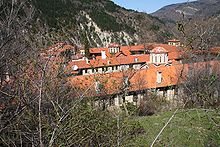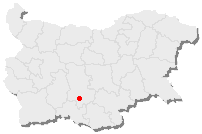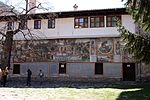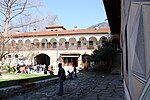Bachkovo Monastery
The Bachkovo Monastery ( Bulgarian Бачковски манастир Batsch Frankowski manastir , Georgian პეტრიწონის მონასტერი Petrizonis monasteri ) is located in Bulgaria about 30 km south of the second largest city of Plovdiv right next to the town of Asenovgrad (8 km south) on the northern edge of the densely forested Rhodope -Gebirges on the right bank the Assenitsa River, which flows into the small Chaya River. The Bulgarian Orthodox Batschkowo Monastery is the second largest monastery in Bulgaria and reports directly to the Bulgarian Patriarch (→ Patriarchal Monastery ).
Along with the Rila Monastery , the complex is one of the most important pilgrimage centers in Southeastern Europe and is considered a national shrine . Accordingly, it is an important center of religious tourism in the country and is listed among the 100 national tourist objects of Bulgaria created by the Bulgarian Tourism Association .
history
The monastery was founded in 1083 by the Byzantine commander of the Philippopolis area Gregor Pakourianos and his brother Abas. In the 13th century, the Iberians lost control of the monastery, but the influence of Georgian culture and tradition was retained in the monastery until the 14th century. Gregor Pakourianos had received land in the Balkans from the Byzantine emperor for his services. On this he had the monastery built, with many donations, dedicated to the Mother of God. That is why the monastery is also called "Assumption of Mary". In the monastery young people were trained as monks and teachers. The history of the monastery was very changeable. Until the 12th century, the monastery housed mainly Georgian monks according to the donor's will. When the monastery was taken over by the Bulgarian state, it received very generous gifts from the Bulgarian rulers, of which the tsars Ivan Assen II (1218–1241) and also Ivan Alexander (1331–1371) should be emphasized.
During the second Bulgarian empire (14th century) the monastery developed into one of the most important spiritual centers in Bulgaria. It was famous for its writing school. Probably the last medieval patriarch Euthymios of Tarnowo died here . Even during the "500 years of Turkish rule" the monastery made important contributions to the preservation of the Bulgarian culture and language. Despite temporary suspension, which probably took place around the change from the 14th to the 15th century and which lasted almost a hundred years, the monastery was able to preserve numerous manuscripts and books in Cyrillic and Bulgarian for centuries after it was re-founded around 1600 .
Buildings
Aside from the imposing complex, the monastery has three church buildings and an ossuary (ossuary).
The more than 300 year old tree in the courtyard, a Chinese jujube , is a botanical specialty . An aromatic schnapps, the "Dschindschifilowa Rakija ", is distilled from the fruit .
The originally preserved wing of the north courtyard, built in 1601, houses the refectory , the monks' dining room and the monastery cellar for storing food supplies and wine in its southern part . The living rooms of the abbot are on the upper floor. On the outer walls of the upper floor you can see scenes from the history of the monastery, including fragments of frescoes by Alexy Atanassov from 1846.
Bachkovo ossuary
The ossuary is one of the oldest buildings in the monastery; structurally, it probably goes back to the 11th century, the time the monastery was founded. It is painted with frescoes from the 12th, 14th and 19th centuries. The two-story building is constructed like a one-nave basilica . The ossuary is on the ground floor and a cemetery church is on the upper floor. One of the most famous wall paintings is the composition "The vision of the prophet Ezekiel" from the 12th century, and pictures of the monastery donors can also be seen. The Bulgarian Tsar Ivan Alexander (1331-1371) is depicted in the church porch on the upper floor . Due to its wall paintings, the Batschkovo ossuary is one of the most outstanding cultural monuments in Bulgaria.
refectory
The dining room of the monastery ( refectory ) was built like the monastery kitchen in 1601 and decorated with frescoes until 1643. The wall paintings in the refectory have only recently been restored. On the eastern side the Bible scenes “The Last Judgment” and “The Paradise” are shown, in the apse (niche) you can see “The Seated Mother of God”. The vault shows the "family tree of the Savior" (from Auraamus to Christ). Other wall paintings show ancient Greek philosophers, scholars and writers, Old Testament heroes and “The Meeting of the Space Councils”. Also worth seeing is the long marble table in the refectory from 1601; it has eight legs, which are arranged one behind the other in a row.
Church "Sweti Archangeli" (Archangel Church)
The only building that survived the fire of 1595 unscathed, and therefore the oldest preserved church building in the monastery, is the Archangel Church (Bulgarian: "Sweti Archangeli"). The building probably dates from the 12th century and was used as a winter church.
The vault paintings on the first floor and the wall paintings on the second floor date from 1841 to 1846. They were made in the style of the Bulgarian rebirth by Sakari Sograf , a well-known master of the Samokov school. Among other things, the impressive frescoes “The parable for the rich and poor Lazarus”, “The ten virgins”, “The poor widow” and “Before the threshold of death” can be seen.
Main church "Uspenie Bogoroditschno"
The central monastery church from 1604 is dedicated to the Blessed Mother Mary "Sweta Bogorodiza" and her deceased (also: Assumption of Mary). This is a cross-domed church with a cylindrical apses drum dome , which is covered with orange red bricks Platt. The church porch was painted in 1643, the central part in 1850. In the altar area of the church a canopy of the sacred altar table from 1637 has been preserved. The miraculous iconostasis (icon wall) from the 18th century consists of the following icon representations (painted from 1793):
- the Holy Mother of God with the baby Jesus (shown with three hands!)
- the Virgin from the Rhodope Mountains
- the blessing Christ
- St. John the Baptist
- St. Nicholas
- St. Dimitri
A legend tells about the icon of the three-handed Holy Mother of God that the image was painted in the first centuries of early Christianity and transferred to the Batschkovo monastery in 1311 as a gift from pious Georgians. The icon was framed with a silver coat in 1819 and is also known as "The Mother of God from Iwer".
Chapel "Sweti Nikola" (St. Nicholas)
The chapel was built in 1836 in honor of St. Nicholas. The young Sachari Sograf painted them in 1840; the frescoes are among his earliest artistic achievements. The compositions “The Last Judgment” and “The Paradise” are located in the open church forecourt . Above this you can see a self-portrait of the artist as well as representations of the abbot and his deputy. Further frescoes are “The first parents Adam and Eve” and the first fratricide “Cain kills Abel”.
museum
In the monastery museum there is an extensive collection with old worship books, church equipment, old coins and anniversary jewelry.
Todays use
Monks still live in the monastery complex, which also offers overnight accommodation for pilgrims and travelers. The monastery museum has a rich collection of church objects, icons and books. You can also see a sultan ferman from 1452 and a sword that, according to legend, Emperor Friedrich Barbarossa left here during his crusade. Once a year - in July - population groups come together in the monastery to celebrate their family festivities together. From child baptisms to weddings to funeral celebrations for those who died in the past year. On these days, the guests of these celebrations can also get accommodation in the monastery. This gathering is an important link in the cultural and ethnic bond.
In 2017, Arte Re aired: a documentary about the "bridal market" in Batschkowo, where Roma arranged marriages.
literature
- Elka Bakalowa (Ed.): The ossuary of the Bachkovo monastery. Pigmaliom, Plovdiv 2003. ISBN 954-8336-86-3
Individual evidence
- ↑ See: Hans-Dieter Döpmann : The Orthodox Churches in Past and Present in Trier Treatises on Slavic Studies , Volume 9, 2010, p. 96; Gautier, P. 1984. 'Le typikon du sébaste Grégoire Pakourianos,' Revue des Etudes Byzantines, 42: 5-145; Louis Petit, Typikon de Grégoire Pacourianos pour le monastère de Pétritzos (Bachkovo) en Bulgarie, original texts, Viz. Vrem., XI, Suppl. No 1, SPB 1904, XXXII + 63 p.; Cf.: Anna Komnene : Alexias . Trans., Included. and with note vers. by Diether Roderich Reinsch. DuMont, Cologne 1996 (2 ed.). ISBN 3-7701-3492-3 .; Gérard Dédéyan (dir.), Histoire du peuple arménien, private, Toulouse, 2007 ( ISBN 978-2-7089-6874-5 ), p. 317; (ru) VA Arutiunova - Fidanian, Tipik Grigoriia Pakuriana, Erevan, 1978, p. 249 (34-43); Encyclopédie Universalis .
- ↑ (bg) http://svyat.com/джинджифилът-е-много-перспективна-ку/
Web links
- www.travelbilder.de , picture gallery with 29 photos
- Edouard Selian. The Iberian Monks of the Petritzos (Bachkovo) Monastery. October 14, 2009. http://www.americanchronicle.com/articles/view/123992 ( Memento of April 5, 2012 on the Internet Archive )
Coordinates: 41 ° 56 ′ 35 ″ N , 24 ° 48 ′ 52 ″ E










